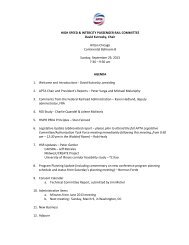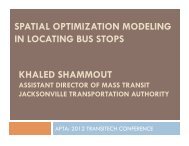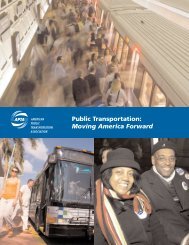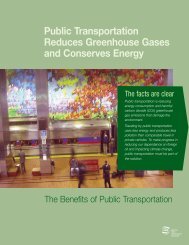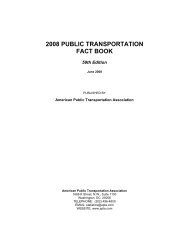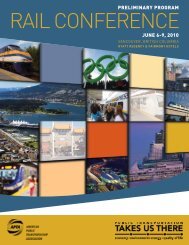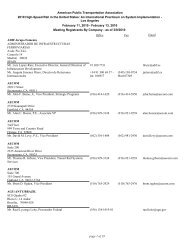2012 APTA Fact Book Appendix A - American Public Transportation ...
2012 APTA Fact Book Appendix A - American Public Transportation ...
2012 APTA Fact Book Appendix A - American Public Transportation ...
Create successful ePaper yourself
Turn your PDF publications into a flip-book with our unique Google optimized e-Paper software.
<strong>2012</strong> <strong>Public</strong> <strong>Transportation</strong> <strong>Fact</strong> <strong>Book</strong>,<br />
<strong>Appendix</strong> A: Historical Tables<br />
GLOSSARY<br />
Definitions are grouped by topic in the following categories:<br />
• General Definitions<br />
• Employee and Labor Definitions<br />
• Energy Use and Vehicle Power Definitions<br />
• Financial - Capital Expense Definitions<br />
• Financial - Operating Expense Definitions<br />
• Financial - Passenger Fare Structure Definitions<br />
• Financial - Revenue Definitions<br />
• Infrastructure – Rights-of-Way and Maintenance Facility Definitions<br />
• Infrastructure – Passenger Station Definitions<br />
• Mode of Service Definitions<br />
• Operating Data - Service Supplied Definitions<br />
• Passenger Data - Service Consumed Definitions<br />
• Service Availability and Commute Mode Definitions<br />
• Vehicle Characteristics Definitions<br />
• Vehicle Equipment Definitions<br />
GENERAL DEFINITIONS:<br />
Page 127<br />
<strong>Public</strong> <strong>Transportation</strong> (also called transit, public transit, or mass transit) is transportation by a<br />
conveyance that provides regular and continuing general or special transportation to the public, but not<br />
including school buses, charter or sightseeing service.<br />
Transit agency (also called transit system) is an entity (public or private) responsible for administering<br />
and managing transit activities and services. Transit agencies can directly operate transit service or<br />
contract out for all or part of the total transit service provided. When financial and oversight responsibility<br />
is with a public entity, it is a public transit agency. When more than one mode of service is operated, it<br />
is a multimodal transit agency.<br />
EMPLOYEE AND LABOR DEFINITIONS:<br />
Capital Employee is a transit agency employee whose labor hour cost is reimbursed under a capital<br />
grant or is otherwise capitalized. Generally, only large transit agencies have such employees.<br />
Employees of contractors and suppliers of products are not included.<br />
Employee is a person who works for a transit agency including employees of providers of purchased<br />
transportation service..<br />
Employee Compensation is the sum of the amount of pay employees receive in salaries and wages plus<br />
the cost to the transit agency on fringe benefits to employees and employment related tax payments.<br />
Only compensation for employees of the transit agency is included, compensation for employees of<br />
purchased transportation service providers is reported in purchased transportation expense.<br />
Fringe Benefits are payments to employees for time not actually worked and the cost of other employee<br />
benefits to the transit agency. Payment for time not actually worked includes payments to the employee<br />
for vacations, sick leave, holidays, and other paid leave. Other benefits include transit agencies<br />
payments to other organizations for retirement plans, social security, workmen's compensation, health<br />
insurance, other insurance, and other payments to other organizations for benefits to employees. Only



